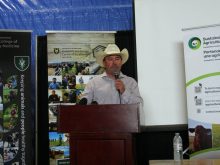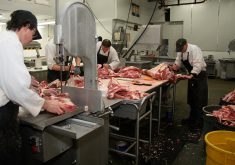Dairy producers use beef genetics to capture more value for their animals, and beef experts say it benefits both sectors
Glacier FarmMedia – Canada’s dairy producers say an injection of beef genetics is a good bet for their bottom line.
The idea is to reserve the breeding of dairy replacements for the top cows in the herd, usually with sexed semen to maximize the odds that top milkers will carry genetics to their daughters. Calves from the rest of the herd can be beef hybrids, which diversifies the business and captures more value.
Beef cattle prices are still flying high, which also benefits the dairy sphere and producers who are getting more for calves.
Read Also

More work wanted on removing red tape
REGINA — Canadian farmers risk falling further behind competitors if two main federal agencies don’t become more efficient and responsive…
Beef producers may not welcome a surge of crossbred cattle horning in on their gravy train. Others may worry about the genetic implications of the beef-on-dairy trend.
A long-time beef industry leader says he isn’t worried.
Dennis Laycraft, executive vice-president of the Canadian Cattle Association, said the beef-on-dairy trend is unlikely to harm the beef sector.
“It’s not, in my mind, a concern that they’re going to saturate our market at all. Quite the opposite,” he said. “I think we’ve got room to grow, both in terms of beef cow numbers and our export trade around the world. So, the fundamentals are all strong.”
There’s plenty of beef demand to go around, Laycraft added. In fact, “demand for high quality beef is growing faster than production is right now around the world, and this is forecast to certainly go well into the next decade.”
It’s not only about supply and demand. A sustained market also requires a consistent flow of beef cattle but Canada’s beef herd numbers continue to slip.
The last few years have exacerbated that situation, as drought forced ranchers in Canada’s major beef-raising regions to sell cattle. From 2021-24, the Prairies lost 7.3 per cent of cattle on beef farms, according to Statistics Canada data.
Laycraft also finds it unlikely that beef cattle will lose their place in the sector. They are needed to meet market demand and environmental goals, as well as herd biodiversity.
Dairy-beef hybrids gain weight efficiently after weaning, which limits their carbon footprint, though Laycraft still gives beef cattle an edge on green messaging.
The beef sector has made much of its potential for carbon sequestration, biodiversity and grassland health. Those benefits are often linked to management practices like rotational and extended grazing that keep cattle on the range. Financially, grass is cheap, and many beef herds have been managed for years with an eye to breeding animals that don’t require coddling.
The genetics behind most dairy cattle and hybrids haven’t been put through that crucible.
Carcasses from crosses typically grade well, usually AAA or prime, with good marbling, but Laycraft said beef genetics still achieve the best grades.
“There are some strengths to the beef-on-dairy coming in,” Laycraft said. “It’s a much better animal than a straight dairy animal, but our top-end animals are still our beef-on-beef.”
Feedlot nutrition plans narrow that gap, he added.
“We’ve got some of the most efficient animals in the world. We’ve got some of the most efficient cattle producers in the world. So, either beef on dairy or beef animals, we’ve got a great environmental story to tell, and in my opinion, we’re leading the world.”
Laycraft also said that the beef herd may eventually regain its size. Environmental conditions have improved, he noted, and producers may be approaching circumstances where they restock and rebuild.
“We’re in a good spot to hopefully start to retain more heifers and see some recovery in our cattle numbers.”


















